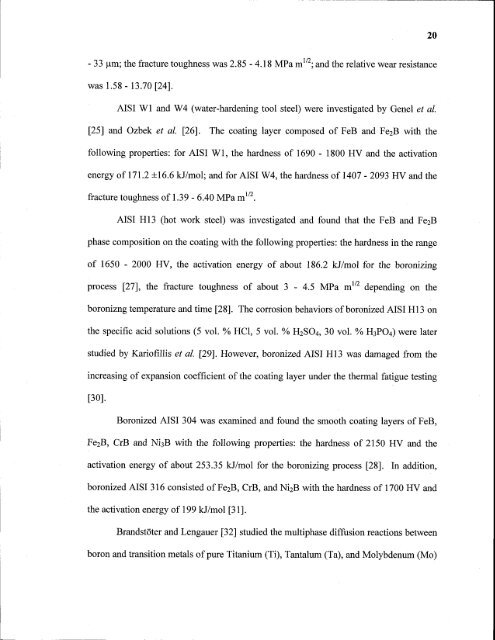Multi-component boron coatings on low carbon steel AISI 1018
Multi-component boron coatings on low carbon steel AISI 1018
Multi-component boron coatings on low carbon steel AISI 1018
Create successful ePaper yourself
Turn your PDF publications into a flip-book with our unique Google optimized e-Paper software.
20<br />
- 33 um; the fracture toughness was 2.85 - 4.18 MPa m ½ ; and the relative wear resistance<br />
was 1.58 - 13.70 [24].<br />
<strong>AISI</strong> W1 and W4 (water-hardening tool <strong>steel</strong>) were investigated by Genel et al.<br />
[25] and Ozbek et al. [26]. The coating layer composed of FeB and Fe2B with the<br />
fol<strong>low</strong>ing properties: for <strong>AISI</strong> W1, the hardness of 1690 - 1800 HV and the activati<strong>on</strong><br />
energy of 171.2 ±16.6 kJ/mol; and for <strong>AISI</strong> W4, the hardness of 1407 - 2093 HV and the<br />
fracture toughness of 1.39 - 6.40 MPa M 1/2 .<br />
<strong>AISI</strong> H13 (hot work <strong>steel</strong>) was investigated and found that the FeB and Fe2B<br />
phase compositi<strong>on</strong> <strong>on</strong> the coating with the fol<strong>low</strong>ing properties: the hardness in the range<br />
of 1650 - 2000 HV, the activati<strong>on</strong> energy of about 186.2 kJ/mol for the <str<strong>on</strong>g>bor<strong>on</strong></str<strong>on</strong>g>izing<br />
process [27], the fracture toughness of about 3 - 4.5 MPa m 112 depending <strong>on</strong> the<br />
<str<strong>on</strong>g>bor<strong>on</strong></str<strong>on</strong>g>izng temperature and time [28]. The corrosi<strong>on</strong> behaviors of <str<strong>on</strong>g>bor<strong>on</strong></str<strong>on</strong>g>ized <strong>AISI</strong> H13 <strong>on</strong><br />
the specific acid soluti<strong>on</strong>s (5 vol. % HCI, 5 vol. % 112SO4, 30 vol. % H3PO 4) were later<br />
studied by Kariofillis et al. [29]. However, <str<strong>on</strong>g>bor<strong>on</strong></str<strong>on</strong>g>ized <strong>AISI</strong> H13 was damaged from the<br />
increasing of expansi<strong>on</strong> coefficient of the coating layer under the thermal fatigue testing<br />
[30] .<br />
Bor<strong>on</strong>ized <strong>AISI</strong> 304 was examined and found the smooth coating layers of FeB,<br />
Fe2B, CrB and Ni3B with the fol<strong>low</strong>ing properties: the hardness of 2150 HV and the<br />
activati<strong>on</strong> energy of about 253.35 kJ/mol for the <str<strong>on</strong>g>bor<strong>on</strong></str<strong>on</strong>g>izing process [28]. In additi<strong>on</strong>,<br />
<str<strong>on</strong>g>bor<strong>on</strong></str<strong>on</strong>g>ized <strong>AISI</strong> 316 c<strong>on</strong>sisted of Fe2B, CrB, and Ni2B with the hardness of 1700 HV and<br />
the activati<strong>on</strong> energy of 199 kJ/mol [31].<br />
Brandstöter and Lengauer [32] studied the multiphase diffusi<strong>on</strong> reacti<strong>on</strong>s between<br />
<str<strong>on</strong>g>bor<strong>on</strong></str<strong>on</strong>g> and transiti<strong>on</strong> metals of pure Titanium (Ti), Tantalum (Ta), and Molybdenum (Mo)
















